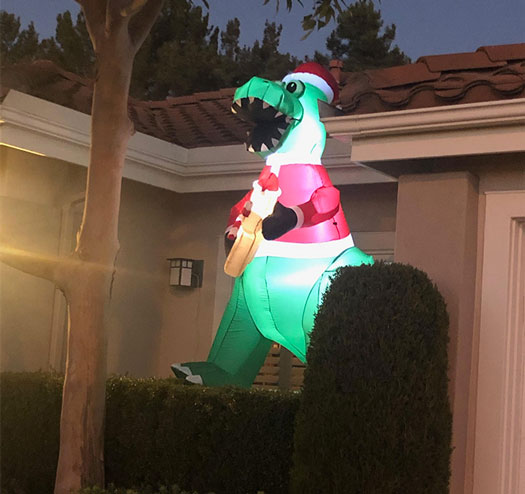Greetings from Palmia Observatory
Well here we are in this holiday season and first of all can offer a "Merry Christmas and Happy Holidays" to everyone, while we wait for the weather to clear and the clouds go away.
We have welcomed a new member to our observatory staff during the Christmas season, so here we see our Resident Chrisma-Saurus, Chris! He wakes up on his own time schedule and pretends to enjoy a gingerbread cookie that is just right size for his 8 foot stature.
 |
| Resident Chrisma-Saurus, Chris (Source: Palmia Observatory) |
He only works from mid-afternoon to late at night and does a good job when he is at it. Afterwards, though he just seems to fall down on the job when his timer says time is up!
 |
| Poor Chris, after a night of feasting, he is, let's just say "HUNG OVER! (Source: Palmia Observatory) |
Ok, ok, so Chris is tired out, but at least the weather forecast is good for one night, maybe two before more cloudy weather and we will be able to get more Saturn-Titan orbit observations.
 |
| Oh-oh, the NightSky App weather prediction is not so good (Source: Palmia Observatory) |
So, while we wait for nighttime, let's check in with SpaceX operations in Boca Chica. We know that last time we saw that Starship SN9, had been repaired and won't be named "Ilene" after all, since its recent fabrication failure when it fell and "leaned" against the high way walls. It was also good to see that the big crane is out on the highway being moved from the fabrication area to the launch area.
 |
| SpaceX giant crane is on the road to the launch pad (Source: LabPadre) |
In this great aerial shot you can just barely make out the big crane slowly moving down the road. When we first visited Boca Chica, we thought that just hanging out on the beach would be a good spot to observe a rocket test launch, but there is only one road to the beach and it is closed to traffic whenever SpaceX transports something on the road or does testing at the launch pad.
 |
| Giant Crane on the road to the Boca Chica beach and launch pad (Source: LabPadre) |
Ok, here we see that the crane has arrived at the launch site and is being put in position to lift Starship SN9 onto the launch pad when the time comes.
 |
| Giant Crane waiting at the launch pad for the arrival of Starship SN9 (Source: LabPadre) |
The Starship SN9 was just a day or two behind the big crane and here we see SN9 already in place on the launch pad with a little help from the big crane. Now all we can do and wait for the last of the engines to be installed and then wait some more for some static fire testing and a big test hop. Go Elon and thanks LabPadre and BocaChicaGal for the great photos and status reports!
 | |
|
Alright the time for some early nighttime observations of Jupiter and Saturn has finally arrived and the clouds are behaving nicely. At the same time, we received a disappointing photo from friend Tom, who relocated to Wisconsin. Check out his "Amazing photo of the Jupiter and Saturn Conjunction." Hmm, sorry about that, Tom! Have you considered a career change to meteorology, just like the rest of us do from time to time?
 |
| Hmm, some Wisconsin observers didn't have a chance (Source: Tom Ralston, Facebook) |
Well here we are almost a week passed the conjunction and everyday we see Jupiter moving out and putting more space between Saturn. My emphasis in photographing the duo is more into making sure the exposure setting is long enough so that Saturn's moon, Titan, shows up in the images. Other OCA members are quite involved in getting very good images of Jupiter and Saturn and its rings, but we are a bit limited because of our short 600mm focal length. Nonetheless, this image is what shows up.
 |
| Jupiter and Saturn, DSLR, 600mm, 1/2 second (Source: Palmia Observatory) |
 |
| Jupiter and Saturn through the palm trees, DSLR, 150mm, 1/15 second (Source: Palmia Observatory) |
So, now that we have had two good observing nights in a row, we can update the plot showing the measured distance between Saturn and Titan. The observed distance is just the pixel difference as it shows up on the photo image. This chart is like the previous one with four good data points, except now the orientation of the X-Y plot has been changed so that the plot orientation better matches the observed location of Titan around Saturn. We will keep updating this chart as more observations become available.
 |
| X-Y Plot for Saturn-Titan orbital measurements (Source: Palmia Observatory) |
We know that Titan has an orbital period of about 16 days, but we don't know much about the inclination of the orbital plane to our line of sight. We know that the moon is never eclipsed by Saturn, but we don't know much about its overall orientation. But, if we just make an eyeball type of guess and show proposed orbit as if we are viewing it inclined in the Y-Z plane and also a bit rotated in the X-Y plane. My guess, so far, is shown below. The plot is calculated starting with a circular orbit and then changing the orbital plane to adjust it to our assumed viewing position. As more data points are collected we will get a better sense of the overall orientation.
 |
| Conceptual inclination viewing test case for assumed circular orbit (Source: Palmia Observatory) |
See you next time,

No comments:
Post a Comment